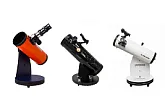Бързо ръководство за начинаещи астрономи
CAUTION!
Never look directly at the Sun — even for an instant — through your telescope or finderscope without a professionally made solar filter that completely covers the front of the instrument, or permanent eye damage may result. To avoid damage to the internal parts of your telescope, make sure the front end of the finderscope is covered with aluminum foil or another nontransparent material.
Children should use the telescope under adult supervision only.
This informational leaflet contains summary information about the different types of telescopes and the most common beginner's mistakes.
If you're just getting started in astronomy, operating your first telescope - arm yourself with patience and persistence. You will certainly succeed if you follow the user manual instructions, as well as the recommendations described below. Perhaps you will want to expand your instrument’s capabilities over time – in this case you will need to acquire additional telescope accessories. But first, you should learn to operate your telescope in its basic configuration.
Learn more about your telescope’s optical design
Reflector. The reflector telescope uses a mirror to gather and focus the light. Depending on the design, the main mirror may be parabolic or spherical. The produced image is reversed upside down and flipped left to right. This does not affect the observed celestial objects, but such telescope design is not suitable for observing terrestrial objects.
Refractor. The refractor telescope uses lenses to gather and focus the light. If you equip a refracting telescope with a diagonal prism or mirror, you will be able to observe terrestrial objects as well. The images become upright (but still left-right reversed).
Mirror-lens telescopes (catadioptric). The two-mirror telescopes, including two most popular designs - the Schmidt-Cassegrain and the Maksutov-Cassegrain. Catadioptric telescopes have more compact dimensions compared to reflectors. As refractors, they are able to produce non-reversed images (using a diagonal mirror or prism) and, therefore, are suitable for terrestrial observations.
Learn more about your telescope mount
Altazimuth mount. This simple mount allows a telescope to move freely in altitude (up and down) and in azimuth (left to right along the horizon). It is also often called an alt-azimuth mount. A simple example of an alt-azimuth mount is a standard camera tripod.
Equatorial mount. Such mount is designed to easily track the daily motion of celestial objects across the sky. The first axis (the polar axis) of the mount is pointed at Polaris (parallel to the Earth's axis), and the second axis (the declination axis) at right angles to the first. Among amateur telescopes the most common type is the German equatorial mount.
Telescopes with automatic guidance are used to quickly locate the desired celestial objects and then track them during observations. Computerized mounts have many different functions and settings (depending on the autoguiding system). This, however, doesn't mean a beginner can’t handle them. The computerized hand controller that features an extensive database of interesting celestial objects will help you operate your telescope.
Common mistakes of novice astronomers
Incorrect assembly, accessories installation. Make sure that you assembled the telescope exactly as illustrated in the user manual. Once again, review all the accessories included in the kit. Carefully check all the steps of the installation process. For example, check if the diagonal mirror is installed (except reflectors), or if the protective cap is removed. Make sure you clearly understand the function of each part of your telescope. This will significantly simplify and secure its use.
I want everything at once. If you are a beginner, do not try to use all accessories at one time. First, learn how to focus your telescope with an eyepiece at close objects and at infinity. Then try to do so with an eyepiece plus Barlow lens.
My telescope does not zoom images. It is important to understand the difference between the eyepieces with fixed focal length and zoom eyepieces (eyepieces with variable magnification). Fixed focal length eyepieces are not able to zoom the image in or out.
I can’t see anything. Make sure that your telescope is properly focused - read this section of the manual very carefully. If necessary, lubricate the moving parts with motor oil to ensure smooth interaction.
Забранява се всяко възпроизвеждане на материала с цел публична публикация във всякаква информационна среда и във всякакъв формат. Можете да реферирате към тази статия с активна връзка към bg.levenhuk.com.
Производителят си запазва правото да прави промени на цените, гамата продукти и спецификациите им или да преустанови предлагането на продуктите без предварително уведомление.



